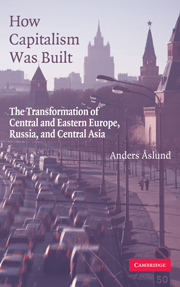Book contents
- Frontmatter
- Contents
- List of Tables and Figures
- List of Abbreviations
- Acknowledgments
- Introduction: A World Transformed
- 1 Communism and Its Demise
- 2 Shock Therapy versus Gradualism
- 3 Output: Slump and Recovery
- 4 Liberalization: The Creation of a Market Economy
- 5 From Hyperinflation to Financial Stability
- 6 Privatization: The Establishment of Private Property Rights
- 7 An Inefficient Social System
- 8 Democracy versus Authoritarianism
- 9 From Crime toward Law
- 10 The Role of Oligarchs
- 11 The Impact of the Outside World
- Conclusions: A World Transformed
- Bibliography
- Index
1 - Communism and Its Demise
Published online by Cambridge University Press: 05 September 2012
- Frontmatter
- Contents
- List of Tables and Figures
- List of Abbreviations
- Acknowledgments
- Introduction: A World Transformed
- 1 Communism and Its Demise
- 2 Shock Therapy versus Gradualism
- 3 Output: Slump and Recovery
- 4 Liberalization: The Creation of a Market Economy
- 5 From Hyperinflation to Financial Stability
- 6 Privatization: The Establishment of Private Property Rights
- 7 An Inefficient Social System
- 8 Democracy versus Authoritarianism
- 9 From Crime toward Law
- 10 The Role of Oligarchs
- 11 The Impact of the Outside World
- Conclusions: A World Transformed
- Bibliography
- Index
Summary
All happy families are similar, but every unhappy family is unhappy in its own way.
Lev Tolstoy, Anna KareninaToday, the case for socialism is no longer persuasive, but this was not always so. Once, many intelligent people considered socialism not only morally but also economically superior to capitalism and democracy. They thought a benign state would pursue higher ideals than a petty democracy and execute them more effectively. Marxist-Leninist ideas and socialist institutions conditioned the postcommunist transition. To provide some background, I review the essence of the Soviet-type system. As communism broke down, countries faced very different political and economic preconditions, and their collapses proceeded in sharply contrasting ways.
Real Socialism
Karl Marx, Friedrich Engels, Vladimir Lenin, and other communist theoreticians left many ideas on how to develop a socialist state, but Josef Stalin was the one who formed the classical communist economic system with the first five-year plan of 1929–33. This system remained intact until his death in March 1953, and he imposed it on all countries in the Soviet bloc. Despite many reform attempts, the lasting changes were remarkably small. This system was the least common denominator of all the countries discussed in this book. The institutional barriers built to reform it were formidable.
- Type
- Chapter
- Information
- How Capitalism Was BuiltThe Transformation of Central and Eastern Europe, Russia, and Central Asia, pp. 11 - 28Publisher: Cambridge University PressPrint publication year: 2007



